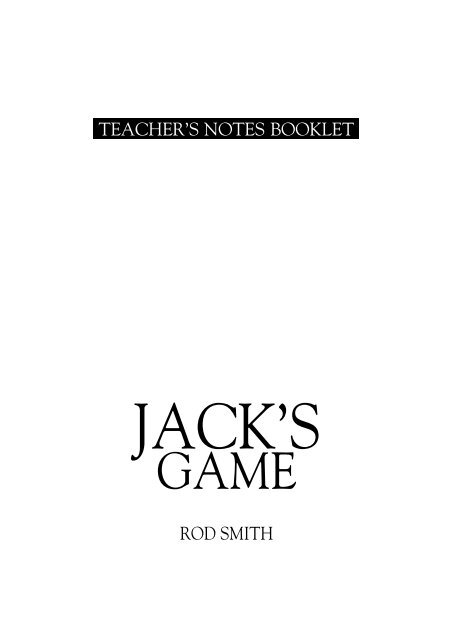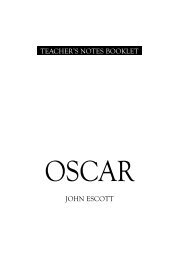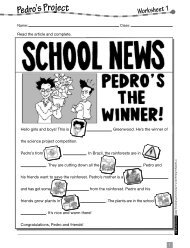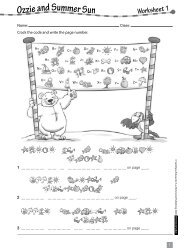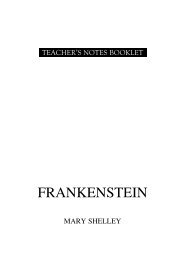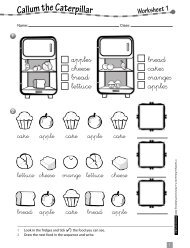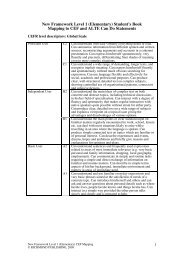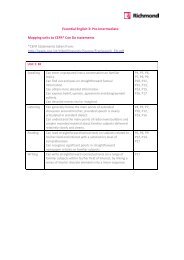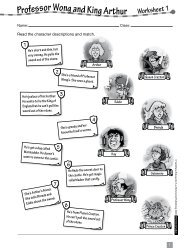Jack's Game - Supadu
Jack's Game - Supadu
Jack's Game - Supadu
Create successful ePaper yourself
Turn your PDF publications into a flip-book with our unique Google optimized e-Paper software.
TEACHER’S NOTES BOOKLET<br />
JACK’S<br />
GAME<br />
ROD SMITH
CONTENTS<br />
Background information 3<br />
Activities before reading the story 4<br />
Activities while reading the story 4<br />
Activities after reading the story 6<br />
Extended writing 6<br />
Projects 8<br />
Worksheets 9<br />
Key to Book Exercises 15<br />
GRADING SCHEME<br />
LEVEL ONE (500 headwords)<br />
present simple<br />
present continuous (present)<br />
going to (future)<br />
past simple<br />
imperative<br />
can (ability and permission)<br />
would like (requests and offers)<br />
must (obligation)<br />
let’s, shall (suggestions)<br />
gerunds<br />
adverbs (time, manner and place)<br />
adjectives (comparatives and superlatives)<br />
LEVEL TWO (800 headwords)<br />
all of the above, plus<br />
present continuous (future)<br />
going to (intentions)<br />
present perfect<br />
past continuous<br />
past perfect<br />
passive (simple forms)<br />
will/shall (future, requests and offers)<br />
must/can’t (deduction)<br />
have to (obligation)<br />
should (advice)<br />
gerund as subject<br />
too/enough + adjective<br />
reported speech (with ask/tell/say)<br />
zero and first conditional<br />
defining relative clauses<br />
LEVEL THREE (1200 headwords)<br />
all of the above, plus<br />
present perfect continuous<br />
passive (all tenses excluding modals)<br />
was/were going to<br />
used to<br />
make/let<br />
may/might (possibility)<br />
reported speech<br />
LEVEL FOUR (1800 headwords)<br />
all of the above, plus<br />
past perfect continuous<br />
future perfect<br />
future continuous<br />
passive (modals)<br />
had better/would rather<br />
second and third conditionals<br />
2
JACK’S GAME<br />
BACKGROUND INFORMATION<br />
Canada<br />
Canada is part of the North American continent,<br />
situated north of the 49th parallel of latitude (the line<br />
for most of the border with the United States). Much<br />
of Canada is a wild empty land, full of lakes in the<br />
summer and covered in snow and ice in the long,<br />
cold winters. In the west are the Rocky Mountains.<br />
These are made up of many mountain ranges running<br />
from north to south, parallel to the coast. One range<br />
is called the Saint Elias Mountains.<br />
The mountains are very high and often have snow<br />
all year round. Between the mountains, rivers have<br />
cut great valleys where fruit trees and arable crops<br />
grow in summer. Near the border with the United<br />
States, peaches and nectarines grow. Further north<br />
there are apples, pears and plums.<br />
The rivers are the providers of life in these mountains<br />
and valleys. They provide the water for animals and<br />
people to drink and for plants to grow. They contain<br />
fish and other creatures that people and animals eat.<br />
When only the Indians lived in the valleys, there<br />
were a lot of fish in these rivers. Now there are fewer<br />
and fewer fish because of the canning industry and<br />
pollutants in the water.<br />
The rivers were the main highways for Indians with<br />
canoes and they are still the main arteries for communication.<br />
Roads, railways, telephone and television<br />
cables follow their courses. Rivers also provide<br />
electricity by driving turbines as they fall down the<br />
mountains. A lot of electricity in Canada is made in<br />
this way, but when the rivers in the north freeze,<br />
electricity has to come from somewhere else. Many<br />
towns or large buildings are connected to the main<br />
national supply, as well as having their own way of<br />
making electricity.<br />
Native Americans<br />
The original inhabitants of Canada and the United<br />
States were what we call the Indians or Native<br />
Americans. These peoples knew no borders and lived<br />
by hunting, fishing and gathering fruits. Many small<br />
groups of Indians lived in the valleys of the<br />
Rocky Mountains.<br />
Nowadays most Indians live on reservations. These<br />
are areas of land set aside by the government where<br />
the Indians can live by hunting, fishing and growing<br />
fruits and cereals if they wish. The reservations<br />
themselves have no fences surrounding them, but<br />
areas within them may be fenced off to protect crops<br />
or orchards.<br />
Indians have their own local governments, are<br />
policed by special police, and more and more often<br />
now run their own commercial businesses trading<br />
with the rest of the country.<br />
Fertilisers and weed killers<br />
From ancient times, people have used various waste<br />
products to make the earth more fertile. In more<br />
modern times various chemicals have been found<br />
to make certain plants grow better or die completely.<br />
Some plants are good to eat, whereas some are<br />
known as weeds and people try to get rid of them.<br />
Scientific research into chemicals that kill plants or<br />
change the way they grow is carried out all over the<br />
world. Experiments that determine the effect of<br />
chemicals on plants and people are usually controlled<br />
by governments because of the possible damage to<br />
the environment.<br />
Such experiments should be carried out in places<br />
where there is no chance of affecting crops or people.<br />
Some companies that manufacture these chemicals<br />
have done experiments without bothering about such<br />
precautions. The resulting chemicals in the soil<br />
change the water in the rivers when it rains. The river<br />
water then affects all the animals and people in the<br />
valley of that river and all the way to the sea. It then<br />
consequently affects the creatures and plants in the<br />
sea.<br />
3
JACK’S GAME<br />
TO THE TEACHER<br />
Welcome to the Teacher’s Notes for the Richmond<br />
Reader Jack’s <strong>Game</strong>. Here you will find a wide<br />
variety of activities based on the story. Materials for<br />
the students are given on the worksheets on pages<br />
9 to 14.<br />
There are six worksheets. Photocopy them as you<br />
need them for your students. Each activity in the<br />
Teacher’s Notes that uses a worksheet indicates<br />
which worksheet to use after its title.<br />
All the activities have suggestions for class management.<br />
They are labelled as whole class, group, pair or<br />
individual tasks or a combination.<br />
You may want to assign the individual activities for<br />
homework, but make sure that the students know<br />
exactly what to do before they start. Some of the<br />
activity types may be new to them.<br />
Activities before reading the story<br />
Do not give students the book yet.<br />
1 Background No WS Pairs, then whole class<br />
• Put your students in pairs. You may like to ask<br />
them to decide who will write the notes and who<br />
will be the speaker.<br />
• Ask them to talk about and write notes on what<br />
they know about western Canada and about<br />
Indians today.<br />
• When they have finished ask them in turn to<br />
share their ideas with the whole class. During the<br />
discussion you can bring in the Background<br />
Information from page 3, and any other relevant<br />
information you may have.<br />
2 Jumbles WS 1 Pairs or individuals<br />
• Put your students in pairs if you wish. Hand out<br />
Worksheet 1 and read through the rubric with<br />
the classs.<br />
• Set a time limit if necessary.<br />
Answers<br />
2 game 3 weather 4 office 5 laboratory<br />
6 angry 7 building 8 flowers 9 people<br />
10 coat 11 interesting 12 hair<br />
3 Matching WS 1 Pairs or individuals<br />
• The first page of the story contains four past<br />
tenses, so this will help your students to read it<br />
without having to look anything up.<br />
• Put your students in pairs if you wish and read<br />
through the rubric with them.<br />
• Set a time limit if necessary. This should be a<br />
short activity.<br />
Answers<br />
1 h 2 f 3 e 4 c 5 g 6 j 7 d 8 a 9 b 10 i<br />
4 Better with Butramex WS 1 Whole class<br />
• Make sure your students have Worksheet 1. Ask<br />
them to look at the advertisement for Butramex.<br />
• Go through the questions with them and discuss<br />
the answers as a class. Bring in some agricultural<br />
and environmental vocabulary.<br />
5 Talk about the picture WS 2 Whole class or<br />
pairs<br />
• Put your students in pairs if you wish. Hand out<br />
Worksheet 2 and read through the rubric with<br />
them.<br />
• Discuss the picture and the answers to the<br />
questions.<br />
6 Look at the book No WS Pairs, then whole<br />
class<br />
• Give your students the book. Ask them to look<br />
through it and discuss it with their partners.<br />
• Ask them to find the chapter headings and write<br />
them down.<br />
• Then discuss what the pictures and chapter<br />
headings make them think will happen in the<br />
story.<br />
Activities while reading the story<br />
7 People in the story WS 2 Pairs or individuals<br />
• This activity should be started after reading the<br />
Prologue.<br />
• Explain the idea of a list of characters (usually<br />
known as Dramatis Personae) who appear in a<br />
story. It is common practice when printing the<br />
texts of plays to print all the characters’ names on<br />
the first page. This convention is sometimes used<br />
in books as well.<br />
4
JACK’S GAME<br />
• Ask your students to write the names of the<br />
characters they have read about so far in the grid,<br />
each one followed by a short description. Rod<br />
Smith (the author) is given as an example.<br />
• After the Prologue they will be able to write<br />
about Laura deLuce and Jack. As they continue<br />
with the story they will learn Jack’s surname and<br />
also be able to complete Mike Fallon, Oscar<br />
Strode and Jim Sawchuk. By the end of Chapter<br />
4 they should have all these characters listed on<br />
their worksheets.<br />
8 Computer WS 3 Pairs or individuals<br />
• This activity should be done after reading<br />
Chapter 1.<br />
• Hand out Worksheet 3 and put the class in pairs<br />
if you wish.<br />
• Read through the rubric with them. Set a time<br />
limit if necessary.<br />
• Your students will probably label the following<br />
easily from the story: screen, printer, paper, keyboard,<br />
printout. They may also label these from<br />
experience or interest: cable, disc drive, on/off<br />
switch, disc box, mouse, mousepad.<br />
9 The White River WS 3 Pairs or individuals,<br />
then whole class<br />
• This activity should be done after reading<br />
Chapter 2.<br />
• Ask students to label the map with the names<br />
provided.<br />
• When they have finished check that they have<br />
understood where the places are.<br />
10 Order of events WS 4 Pairs or individuals<br />
• This activity should be done after reading<br />
Chapter 3.<br />
• Hand out Worksheet 4 and put your students<br />
in pairs if you wish.<br />
• Explain to the students that they have to put the<br />
ten sentences at the bottom of the worksheet in<br />
the order that they happened. They write them<br />
in the chart provided. They can use the book for<br />
reference.<br />
• Set a time limit if necessary. When they have<br />
finished, go through the answers.<br />
Answers<br />
1 g 2 d 3 i 4 a 5 h 6 j 7 c 8 f 9 b<br />
10 e<br />
• This activity can take quite a long time so do not<br />
start it near the end of a lesson unless your<br />
students can finish it for homework.<br />
• Make sure all your students have Worksheet 4.<br />
• Explain the idea of the storyline as it is on the<br />
worksheet. The first two events are written onto<br />
it. The students will discuss with their partners<br />
which are the other most important events until<br />
now in the story and write them on the line at<br />
suitable intervals. They should leave room for<br />
what happens in Chapter 5. They will need<br />
about a third of the line for that.<br />
• Important events are those that advance the story.<br />
Students should find a way to describe complete<br />
events and not go into detail. For instance all the<br />
stages that Laura went through in Activity 10<br />
could be expressed as ‘9pm. Laura learns water<br />
is toxic - no water in building.’<br />
• When everyone has finished, discuss the moments<br />
they chose as important. You may find it useful<br />
to draw a storyline on the board and reach a<br />
concensus of opinions.<br />
12 Laura’s story No WS Whole class or groups<br />
of 4 or 5<br />
• This activity should be done after reading<br />
Chapter 5.<br />
• This activity allows the students to practise more<br />
if done in groups, but can also take more time.<br />
• Write the following questions on the board.<br />
- What did Laura do when she got away?<br />
- What did she say?<br />
- When and where did she talk to the police?<br />
- What did she tell them?<br />
- How did the police react?<br />
- What did she say in her official statement?<br />
• If the students are working in groups, ask them<br />
to discuss these questions and choose a secretary<br />
to write notes. Ask a different group member<br />
to present the group’s ideas to the class.<br />
• If the whole class is working together, discuss<br />
the questions together and invite students to<br />
write their ideas on the board.<br />
• As a class, make a list of the main points that<br />
Laura would have included in her official<br />
statement.<br />
• You might like to read the Epilogue in class<br />
to round off the story.<br />
11 Storyline WS 4 Pairs or individuals<br />
• This activity should be done after reading<br />
Chapter 4.<br />
5
JACK’S GAME<br />
Activities after reading the story<br />
13 Now you know WS 5 Individuals<br />
• Read through the rubric for Activity 13 with<br />
your students. Set a time limit if necessary.<br />
• If you really feel your students need help, most of<br />
the missing words can be found in the Glossary at<br />
the end of the story.<br />
• When they have all finished check through their<br />
answers.<br />
Answers<br />
2 prove 3 noise 4 ladder 5 ice 6 sender<br />
7 wheel 8 shadows 9 contains 10 force<br />
11 code<br />
14 Comparatives and superlatives WS 5<br />
Individuals<br />
• Make sure your students have Worksheet 5.<br />
• Read the rubric through with them and set a<br />
time limit if necessary.<br />
• When they have finished check through their<br />
answers.<br />
• Ask students to identify which answers are<br />
comparatives and which are superlatives.<br />
Answers<br />
3 the latest<br />
4 more interesting<br />
5 the happiest<br />
6 thirstier/more thirsty<br />
7 worse<br />
8 the farthest/the furthest<br />
9 more beautiful<br />
10 the darkest<br />
11 more comfortable, faster<br />
15 An infinitive follows WS 6 Individuals or pairs<br />
• Put the class in pairs if you wish and hand out<br />
Worksheet 6.<br />
• Students match the first half of a sentence from<br />
List A with the correct ending from List B.<br />
Answers<br />
2 to buy the tickets<br />
3 to cry<br />
4 to see you having a good time<br />
5 to speak the language<br />
6 to sit in the shade<br />
7 to ask for help<br />
8 to go on Saturday<br />
9 to read<br />
10 to move into a bigger house<br />
11 to come in and get dry<br />
16 Who said that? WS 6 Individuals<br />
• Read through the rubric with them and set a<br />
time limit if necessary.<br />
• Students write the name of the character on the<br />
lines provided. They can refer back to the book<br />
if they are unsure.<br />
Answers<br />
1 Jack 2 Strode 3 Fallon 4 Laura 5 Jim<br />
6 Strode/Jim 7 Jim 8 Laura 9 Jack 10 Fallon<br />
Extended writing<br />
17 Heros and heroines No WS Whole class<br />
• Discuss with the whole class each student’s<br />
favourite character in this story. It need not be<br />
a good person. Ask what interests the student<br />
about the character, what is good and what is bad<br />
and how the story shows these things.<br />
• Ask each student to prepare three short<br />
paragraphs about their character: the first to<br />
explain who the person is; the second to explain<br />
the reasons why the student likes that character<br />
and the third to say whether or not the student<br />
would like to be that person and why.<br />
• Read out any interesting ones to the whole class<br />
or display them all where the whole class can<br />
read them.<br />
18 TV script No WS Whole class, then groups or<br />
pairs<br />
• Many stories are made into television dramas<br />
these days. Discuss with your students why this<br />
story could make a good short film (it has some<br />
fast action, some slower scenes, it happens in a<br />
place with beautiful scenery, it has a mystery that<br />
becomes clear, it has a possible romantic couple,<br />
it is about issues that are important to us all, etc).<br />
• Tell them that a production company wants to<br />
make it into a film but first of all they need a<br />
script, not a story. They have been asked to write<br />
part of this script.<br />
• Arrange the class in pairs or groups and ask each<br />
pair or group to decide which episode in the<br />
story they would like to make into a script.<br />
Remind them that it is easier to write a script<br />
from existing dialogue than to make up dialogue<br />
that is not in the story.<br />
• When everyone has chosen a short episode, give<br />
them a copy of the template on page 7 and ask<br />
them to write a scene of no more than two pages<br />
(about 2 minutes of finished film).<br />
6
JACK’S GAME<br />
• When they have finished there may be time to<br />
act out any scenes that can be done in the<br />
classroom.<br />
Sample layout of TV or film script<br />
SCENE 1<br />
EXTERIOR, EARLY MORNING, IN THE CAR PARK<br />
(It is raining. The car park is quiet. LAURA sits in her car waiting for<br />
the rain to stop.)<br />
(She sees JACK come out of the office doors and and go to look at the<br />
flowers. She waits a little longer. She gets out of the car and walks<br />
to the building.)<br />
JACK<br />
(turns to look down at Laura)<br />
Hello. Are you the new girl - Laura deLuce?<br />
(Jack steps back.)<br />
LAURA<br />
(a little afraid at first because he is so tall, then she sees his nice<br />
face)<br />
That’s right.<br />
JACK<br />
Maybe you think I’m not normal, but don’t be afraid of me.<br />
Of course not. But I, er...<br />
LAURA<br />
JACK<br />
You want to know why I’m standing in the rain, talking to the flowers,<br />
don’t you? (etc ... until the end of the scene)<br />
JACK<br />
(laughs)<br />
That’s OK. But don’t stand here in the rain. We can talk later.<br />
LAURA<br />
Bye.<br />
(Laura walks into the building. She is thinking what a strange man<br />
Jack is.)<br />
7
JACK’S GAME<br />
19 Written argument No WS Whole class, then<br />
individuals<br />
• Discuss the form of a written argument with the<br />
class.<br />
1 the statement of the case<br />
2 the argument and points for<br />
3 the argument and points against<br />
4 the opinion of the writer with reasons why<br />
• Write this title on the board: This planet needs<br />
fewer people, not more food.<br />
• You may find some of the following come up in<br />
discussion:<br />
- population difficult to control<br />
- plenty of food but in the wrong places<br />
- should start growing food in the sea<br />
- everyone should have their own piece of<br />
land<br />
- much of the food there is is not good for us<br />
- if there was money in the poor countries<br />
there would be food<br />
• Ask your students to make notes on points for the<br />
statement and points against it. Have a look at<br />
their notes in relation to the four paragraphs<br />
above. Then they can either write the short<br />
paragraphs at home or in class.<br />
• If there is time afterwards and the written arguments<br />
are good enough, you could hold a formal<br />
debate.<br />
20 Jim’s diary No WS Individuals<br />
• Check that your students know what a diary or<br />
journal is and tell them about one or two famous<br />
ones that have been published e.g. The Diary of<br />
Anne Frank.<br />
• Ask them to imagine they are Jim. Discuss Jim’s<br />
character with them. They may have different<br />
ideas about him which should be encouraged.<br />
• Then ask them to write the entry to his diary for<br />
the day he died. It should explain his worries, his<br />
thoughts and his hopes as well as what they imagine<br />
he did until he left home to go to the office<br />
in the evening. They could have in mind that the<br />
police may use information from it to sort out<br />
what happened. And the environmental group<br />
may use it to help win their case to get Butramex<br />
closed down.<br />
Projects<br />
1 Make a poster No WS Pairs or individuals<br />
• Put your students in pairs if you wish.<br />
• Have ready as many sheets of paper as necessary,<br />
all the same size.<br />
• Tell the class that they are going to make<br />
a poster. It could be a poster issued by the<br />
environmental group that Jim and Jack belonged<br />
to. It could be a poster for the film of the story.<br />
It could be something you have thought of<br />
yourself.<br />
• Discuss with them what other posters like theirs<br />
say and look like. Help them choose exactly what<br />
the visual will show and what the words will say.<br />
• Prepare a site to display all the posters where<br />
other classes can see them.<br />
2 How does a river affect people?<br />
No WS Whole class, then individuals<br />
• Discuss how we depend on rivers with the class:<br />
- water for homes and industry<br />
- water for fields<br />
- transport<br />
- hydroelectricity<br />
- fish and other animals<br />
• Help each single student or pair to choose one<br />
aspect to illustrate or write about.<br />
• Give each student the same sized piece of paper<br />
to present their work on and set a time limit if<br />
necessary.<br />
• Make suggestions for illustrations and layout<br />
as the students work.<br />
• Either arrange plenty of space to display the<br />
finished work, or photocopy everyone’s<br />
contribution and make up a booklet. Make<br />
a copy of the whole booklet for each student<br />
to keep.<br />
8
JACK’S GAME<br />
WORKSHEET 1<br />
Do these activities before you read the story.<br />
ACTIVITY 2 Jumbles<br />
Read these sentences and fill in the missing word. The<br />
word is given at the end in capital letters but it is<br />
jumbled. The first one is done for you as an example.<br />
1 He is not wearing his __________________ clothes. He<br />
looks like a banker today! ROLMAN<br />
2 After dinner they are going to play a<br />
____________________________________________ of poker. MEAG<br />
3 The ____________________________________________ is dreadful! It never<br />
stops raining. EERWHAT<br />
4 My mum works in an ____________________________________________ and<br />
my dad in a shop. CEFIFO<br />
5 My mum works in a ____________________________________________ and my<br />
dad in a hospital. TARRBAYOOL<br />
6 Don’t be ____________________________________________ . It was a mistake.<br />
I’m sorry. RYNAG<br />
7 They want to change that ____________________________________________<br />
into a cinema. NUBIGLID<br />
8 We are going to take her some ___________________________________<br />
when we go to the party. LEWSROF<br />
9 Some ____________________________________________ think we must run<br />
five kilometres a day. ELOPPE<br />
10 Your new ____________________________________________ is a lovely colour.<br />
Is it warm? OTAC<br />
11 What are you reading? Is it ___________________________________________ ?<br />
NENTRIGSTEI<br />
12 I must go and have my ____________________________________________ cut<br />
this week. IRAH<br />
ACTIVITY 3 Matching<br />
normal<br />
Match the infinitive of the verb with its past tense.<br />
Write the letter of the past tense in the box beside<br />
the infinitive.<br />
1 get a saw<br />
2 wear b felt<br />
Tons<br />
3 begin c ran<br />
4 run d thought<br />
5 eat e began<br />
6 sit f wore<br />
7 think g ate<br />
8 see h got<br />
9 feel i came<br />
10 come j sat<br />
ACTIVITY 4 Better with Butramex<br />
Look at this advertisement.<br />
Discuss what you think Butramex makes and what it<br />
is made from.<br />
What can go wrong when you work with chemicals?<br />
Are there chemical companies that are not careful<br />
with their chemicals?<br />
Is it more important to make money or to do the<br />
best thing for the planet?<br />
120<br />
110<br />
100<br />
90<br />
80<br />
70<br />
60<br />
50<br />
40<br />
30<br />
20<br />
10<br />
0<br />
ons<br />
T<br />
120<br />
110<br />
100<br />
90<br />
80<br />
70<br />
60<br />
50<br />
40<br />
30<br />
20<br />
10<br />
0<br />
Lemons<br />
Lemons<br />
Lentils<br />
Lentils<br />
Potatoes<br />
LAST YEAR<br />
Tomatoes<br />
Potatoes<br />
THIS YEAR<br />
Tomatoes<br />
Butramex makes the difference!<br />
Peppers<br />
Peppers<br />
9
JACK’S GAME<br />
ACTIVITY 5 Talk about the picture<br />
Do this activity before you read the story.<br />
This is a picture from the story you are going to read.<br />
Look at it and discuss the answers to these questions:<br />
What is this a picture of?<br />
Where do you think it is?<br />
What are the people in the picture doing?<br />
How old are they?<br />
What have they got in their hands?<br />
How do they feel about each other?<br />
When did this story happen?<br />
How do you know?<br />
What do you think is going to happen next?<br />
WORKSHEET 2<br />
Do these activities as instructed.<br />
ACTIVITY 7 People in the story<br />
Start this activity after reading the Prologue.<br />
Fill in the names and notes as you read through the story.<br />
After the Prologue you can fill in two characters and write notes about them.<br />
Rod Smith is the author of this story and is given as an example.<br />
After Chapter 1 you can fill in two more names and write some notes about them,<br />
and after Chapter 4 you should have all the characters listed.<br />
PEOPLE IN THE STORY<br />
Rod Smith<br />
_______________________________________________________________________<br />
teacher and writer, married, lives in Paraguay<br />
_______________________________________________________________________________________________________________________________________________<br />
_______________________________________________________________________________________________________________________________________________<br />
_______________________________________________________________________<br />
_______________________________________________________________________________________________________________________________________________<br />
_______________________________________________________________________________________________________________________________________________<br />
_______________________________________________________________________<br />
_______________________________________________________________________________________________________________________________________________<br />
_______________________________________________________________________________________________________________________________________________<br />
_______________________________________________________________________<br />
_______________________________________________________________________________________________________________________________________________<br />
_______________________________________________________________________________________________________________________________________________<br />
_______________________________________________________________________<br />
_______________________________________________________________________________________________________________________________________________<br />
_______________________________________________________________________________________________________________________________________________<br />
10
JACK’S GAME<br />
ACTIVITY 8 Computer<br />
Do this activity after reading Chapter 1.<br />
Look at this picture of a computer. Label the items in<br />
the picture in English.<br />
If you do not know any words, look in your dictionary.<br />
WORKSHEET 3<br />
Do these activities while you are reading the story, after the chapters given.<br />
ACTIVITY 9 The White River<br />
Do this activity after reading Chapter 2.<br />
This is a map of the area where this<br />
story takes place. Look at the<br />
places below and mark them<br />
on the map.<br />
;;; yyy ; y<br />
;;; yyy ; y<br />
;;; yyy ; y<br />
The White River<br />
Butramex’s fields<br />
The Indian reservation<br />
BUTRAMEX<br />
Kelowak<br />
The Saint Elias Mountains<br />
11
JACK’S GAME<br />
WORKSHEET 4<br />
Do these activities while reading the story, after the chapters given.<br />
ACTIVITY 10 Order of events<br />
Do this activity after reading Chapter 3.<br />
Laura worked hard at being a detective in Chapter 3.<br />
Put these sentences in the order that they happened.<br />
1 2<br />
ACTIVITY 11 Storyline<br />
Do this activity after reading Chapter 4<br />
Look at this line. At the bottom is the beginning of<br />
the story. At the top is the end of the story. Write<br />
the most important moments in the story in boxes<br />
beside the line. Make the line between the boxes long<br />
if a long time passes and short if a short time passes.<br />
Leave some of the line empty for the important<br />
moments in Chapter 5.<br />
3 4<br />
5 6<br />
7 8<br />
9 10<br />
a<br />
b<br />
c<br />
d<br />
e<br />
f<br />
g<br />
h<br />
i<br />
j<br />
She types XOT = OIIH on her computer.<br />
She asks herself a lot of new questions.<br />
She reads the message.<br />
She does not understand the message.<br />
She sees the shadow of a man.<br />
She understands there is no water in the building.<br />
She remembers the message in her desk.<br />
She sees them reflected in Fallon’s screen.<br />
She looks for the file name.<br />
She understands the code.<br />
Oct 16<br />
Laura remembers first day.<br />
Oct 17, 7am<br />
Laura feels something is<br />
wrong in the office.<br />
12
JACK’S GAME<br />
WORKSHEET 5<br />
Do these activities after finishing the story.<br />
ACTIVITY 13 Now you know<br />
Read these sentences and then fill in the missing<br />
words. The words are all new words from the story.<br />
The first one is done for you as an example.<br />
1 My sister has a very good job; she is the<br />
____________________________________________ boss of the logistics section.<br />
2 I can’t ____________________________________________ it, but I think he killed<br />
an Indian.<br />
3 You say it’s music, but I say it’s just<br />
____________________________________________ .<br />
4 How do you clean those windows up there?<br />
Do you have a ____________________________________________ ?<br />
5 Have you got any ____________________________________________ ?<br />
My lemonade isn’t very cold.<br />
6 Who is this e-mail from? There is no<br />
____________________________________________ name.<br />
7 Look at his bicycle. The front<br />
____________________________________________ is broken.<br />
8 The trees make ____________________________________________ on the<br />
road when the sun goes down.<br />
9 Tea ____________________________________________ caffeine, too, you know.<br />
It’s not just in coffee.<br />
10 Sometimes trees by the river are lost because<br />
of the ____________________________________________ of the water.<br />
11 If you write it in ____________________________________________ , only you<br />
and I will understand.<br />
ACTIVITY 14 Comparatives and<br />
superlatives<br />
Complete these sentences. Choose an adjective from<br />
the box and put it in the comparative or the superlative.<br />
The first two are done for you as examples.<br />
dark happy long beautiful<br />
comfortable interesting good late<br />
fast far thirsty bad<br />
1 I felt ____________________________________________ better . He had a nice face.<br />
2 Tomorrow is ____________________________________________ the longest day. The sun<br />
goes down at 23.00.<br />
3 This is ____________________________________________ model. It prints in<br />
colour, a page every 15 seconds.<br />
4 This magazine is ____________________________________________ than yours.<br />
It’s about pop stars.<br />
5 When he stepped laughing off the train, it was<br />
____________________________________________ moment of his mother’s life.<br />
6 Don’t drink it all now. We are going to be much<br />
____________________________________________ this afternoon.<br />
7 The rain got ____________________________________________ and we ran for<br />
the village.<br />
8 The road stops there. It’s ____________________________________________<br />
you can go.<br />
9 The penguin is ____________________________________________ in the water<br />
than it is on the ground.<br />
10 Sam is ____________________________________________ of the three brothers.<br />
The others are almost blond.<br />
11 The Volvo car is ____________________________________________ but the<br />
Honda motorbike is ____________________________________________ .<br />
13
JACK’S GAME<br />
WORKSHEET 6<br />
Do these activities after finishing the story.<br />
ACTIVITY 15 An infinitive follows<br />
Match the two halves of these sentences. Choose the<br />
second half from List B and write it in after the first<br />
half in List A. The first one is done for you as an<br />
example.<br />
List A<br />
1 Oh no! I forgot __________________________________________________________________ to turn off the water .<br />
2 When is the concert? Did you remember<br />
__________________________________________________________________________________________________ ?<br />
3 He fell down and started<br />
__________________________________________________________________________________________________ .<br />
4 Don’t stop playing. I like<br />
__________________________________________________________________________________________________ .<br />
5 If you go to Namibia, are you going to learn<br />
__________________________________________________________________________________________________ ?<br />
6 It’s very hot. Would you like<br />
__________________________________________________________________________________________________ ?<br />
7 I can’t do this. I need<br />
__________________________________________________________________________________________________ .<br />
8 Not today. I prefer<br />
__________________________________________________________________________________________________ .<br />
9 He took the book from my hand and started<br />
__________________________________________________________________________________________________ .<br />
10 The family is bigger now and they want<br />
__________________________________________________________________________________________________ .<br />
11 It’s raining. Would you like<br />
__________________________________________________________________________________________________ ?<br />
ACTIVITY16 Who said that?<br />
Who said these things in the story? Write the name<br />
of the speaker on the line given.<br />
1 The new girl doesn’t like me.<br />
_________________________________________________________________________________<br />
2 I want to see you in my office.<br />
_________________________________________________________________________________<br />
3 You can drive.<br />
_________________________________________________________________________________<br />
4 You’re not being a very good detective.<br />
_________________________________________________________________________________<br />
5 No one must see me.<br />
_________________________________________________________________________________<br />
6 There’s a problem with the electricity.<br />
_________________________________________________________________________________<br />
7 I came to look for a message.<br />
_________________________________________________________________________________<br />
8 Where’s the river?<br />
_________________________________________________________________________________<br />
9 I’m happy to see you two.<br />
_________________________________________________________________________________<br />
10 There they are. Don’t move!<br />
_________________________________________________________________________________<br />
List B<br />
to cry<br />
to go on Saturday<br />
to buy the tickets<br />
to come in and get dry<br />
to speak the language<br />
to see you having a good time<br />
to ask for help<br />
to turn off the water<br />
to read<br />
to sit in the shade<br />
to move into a bigger house<br />
14
JACK’S GAME<br />
KEY TO BOOK EXERCISES<br />
A Comprehension<br />
Chapter 1 The Message<br />
1 Because she has a lot of work to do.<br />
2 Because he knows the Indians on the reservation<br />
and he likes to help them. He also knows a lot<br />
about plants.<br />
3 That it is bad for the environment.<br />
4 A piece of paper.<br />
5 Because the printer is working and she is the only<br />
person in the office.<br />
Chapter 2 At the Reservation<br />
The correct order is: 3, 5, 1, 4, 2.<br />
Chapter 3 The Night Visit<br />
1 False. Strode drives out of the car park with<br />
Fallon.<br />
2 False. The light is not on in her office. There is a<br />
light outside.<br />
3 False. The newspaper is over the guard’s face. He<br />
is sleeping.<br />
4 True.<br />
5 True.<br />
Chapter 4 Where is Jack?<br />
1 ...takes her hand away from his arm.<br />
2 ...there was a problem with the elecricity.<br />
3 ...the day before yesterday.<br />
4 ...for security.<br />
5 ...go to the window.<br />
Chapter 5 In the Tunnel<br />
1 Because Strode turned off the water.<br />
2 Fallon hit him on the back of the head.<br />
3 Because there was something wrong with their<br />
apple trees.<br />
4 Hydroelectric generators.<br />
5 She opens the gates to the river.<br />
B Working with Language<br />
1 a Laura was early for work, so she waited in<br />
the car.<br />
b Strode rang Laura because he wanted to see<br />
her.<br />
c Laura went to Jack’s laboratory, but he wasn’t<br />
there.<br />
d Jim and Laura went into the tunnel and then<br />
they saw Jack.<br />
e Jack was angry, so he hit Fallon.<br />
f Laura climbed over the gates and then she<br />
got out of the tunnel.<br />
2 The correct order is: c, b, e, f, a, d.<br />
15
JACK’S GAME<br />
THE RICHMOND READERS SERIES<br />
The Richmond Readers Series presents a selection<br />
of high quality, original and simplified stories which<br />
have been graded in four levels, from beginner to<br />
upper-intermediate. Our grading scheme has been<br />
devised with reference to the Council of Europe’s<br />
Waystage and Threshold syllabi and the Cobuild lists<br />
of the most frequently occurring words in the<br />
English language. Structures and vocabulary have<br />
been selected according to two criteria:<br />
1 what students are likely to have been taught<br />
2 what students will be able to deduce through<br />
transference from their own language<br />
Each Reader has a glossary and a number of different<br />
exercises to check comprehension and practise<br />
language manipulation.<br />
The Teacher’s Notes Booklets are a unique feature<br />
of the Richmond Readers Series. Each Reader has<br />
an accompanying booklet with photocopiable<br />
worksheets, background notes for the teacher<br />
and ideas for additional activities, discussion work<br />
and project material.<br />
Richmond Readers offer the student<br />
Well-written stories in a variety of styles which<br />
guarantee an enjoyable reading experience.<br />
Language which is carefully graded to ensure that<br />
the Readers will be within the appropriate language<br />
level.<br />
Background information, glossaries and<br />
comprehension exercises to encourage student<br />
autonomy.<br />
Richmond Readers offer the teacher<br />
A broad selection of genres which will appeal<br />
to a wide variety of students.<br />
Support for the teacher, with a large number<br />
of additional activities and projects provided<br />
in the Teacher’s Notes.<br />
Richmond<br />
PUBLISHING<br />
Richmond Publishing<br />
58 St Aldates<br />
Oxford OX1 1ST<br />
United Kingdom<br />
© Richmond Publishing 1997<br />
First published 1997<br />
Revised: 2010<br />
EAN: 8431300108004<br />
All rights reserved.<br />
No part of this work may be reproduced, stored in a retrieval system or<br />
transmitted in any form, electronic, mechanical, photocopying or otherwise<br />
without the prior permission in writing of the copyright holders. Any<br />
infraction of the rights mentioned would be considered a violation of<br />
the intellectual property (Article 270 of the Penal Code). If you need to<br />
photocopy or scan any fragment of this work, contact CEDRO (Centro<br />
Español de Derechos Reprográficos, www.cedro.org).<br />
However, the publisher grants permission for the photocopying of those<br />
pages marked ‘photocopiable’, for individual use or for use in classes taught<br />
by the purchaser only. Under no circumstances may any part of this book<br />
be photocopied for resale.<br />
Design: Giles Davies Design<br />
Illustrations: Kathy Baxendale, Liz Watkins


